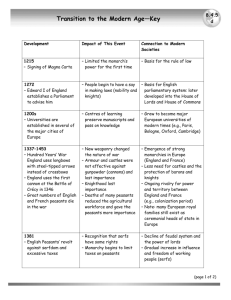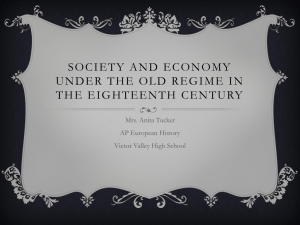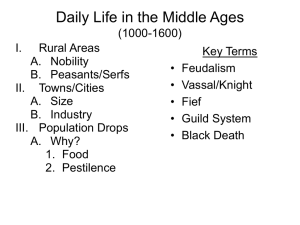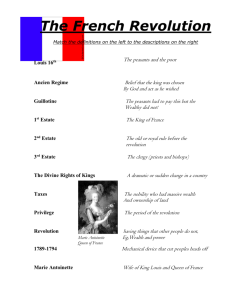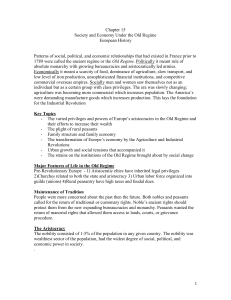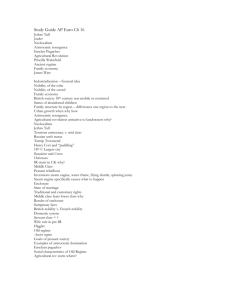Study Guide- Chapter 16
advertisement
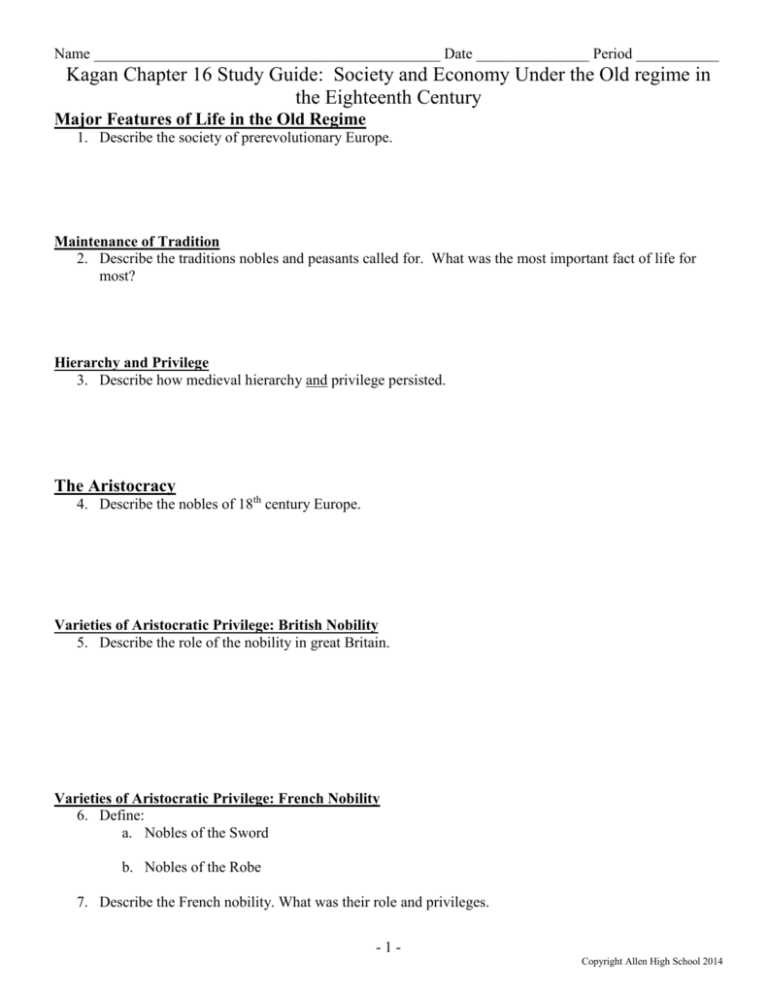
Name ______________________________________________ Date _______________ Period ___________ Kagan Chapter 16 Study Guide: Society and Economy Under the Old regime in the Eighteenth Century Major Features of Life in the Old Regime 1. Describe the society of prerevolutionary Europe. Maintenance of Tradition 2. Describe the traditions nobles and peasants called for. What was the most important fact of life for most? Hierarchy and Privilege 3. Describe how medieval hierarchy and privilege persisted. The Aristocracy 4. Describe the nobles of 18th century Europe. Varieties of Aristocratic Privilege: British Nobility 5. Describe the role of the nobility in great Britain. Varieties of Aristocratic Privilege: French Nobility 6. Define: a. Nobles of the Sword b. Nobles of the Robe 7. Describe the French nobility. What was their role and privileges. -1Copyright Allen High School 2014 Varieties of Aristocratic Privilege: Eastern European Nobilites 8. Describe the role and privileges of Eastern European nobility. a. Poland: b. Austria and Hungary: c. Prussia: d. Russia: Aristocratic Resurgence 9. Describe the aristocratic resurgence and the forms it took. The Land and Its Tillers 10. Explain the importance of land. Peasants and Serfs: Obligations of Peasants 11. Describe the role and obligations of peasants and/or serfs: (make sure you know what countries had peasants, free peasants, and/or serfs) a. France: b. Hapsburg lands: c. Russia: d. Ottoman Empire: Peasants and Serfs: Peasant Rebellions 12. Explain reasons for peasant revolts in Russia vs. England. Give examples. Aristocratic Domination of the Countryside: The English Game Laws 13. Describe Aristocratic domination and give examples. What did the game laws represent and explain the benefits? -2Copyright Allen High School 2013 Name ______________________________________________ Date _______________ Period ___________ Family Structures and the Family Economy Households: Northwestern Europe 14. Describe the households of Northwestern Europe. Including the role and duties of children, marriage, and servants. Households: Eastern Europe 15. Describe the structure the household and pattern of marriage in Eastern Europe. Give examples. The Family Economy 16. Describe the family economy. Why did Europeans work this way? What were the exceptions. Be sure to include descriptions/notes on urban families. 17. Describe the impact of death in the family in Western Europe. 18. Describe the family economy in Eastern Europe. Women and the Family Economy 19. Describe the life of most women in preindustrial Europe. Include growing up, marriage, child bearing, child rearing, work, and education. Children and the World of the Family Economy 20. Describe the life of children in Europe. Be sure to include notes from the whole section. Art and the West: The Breakfast and Return from Market: Two Scenes of Domestic Life 21. Describe Genre painting. -3Copyright Allen High School 2014 The Revolution in Agriculture 22. Describe the impact of poor harvests. The Revolution in Agriculture: New Crops and New Methods 23. Describe the advances in agriculture, including crops, methods, and people: a. Dutch: b. English: The Revolution in Agriculture: Enclosure Replaces Open-Field Method 24. Why were many of the innovations incompatible with the existing organization of land in England? 25. Explain the enclosure movement and the effects. Why were they so controversial? The Revolution in Agriculture: Limited Improvements in Eastern Europe 26. Describe the difference with agriculture in Easter Europe, be sure to include the countries. Expansion of the Population 27. Describe the effect and impact of rising population. Include population numbers through out Europe. What are reasons for the population increase? The Industrial Revolution of the Eighteenth Century 28. Describe the impact of the industrial revolution on Europe. A Revolution in Consumption 29. List characteristics of the Industrial Revolution. -4Copyright Allen High School 2013 Name ______________________________________________ Date _______________ Period ___________ 30. Describe the Revolution in Consumption. Include supply and demand, social factors, marketing, changes, and criticism. Be sure to have examples. Industrial Leadership of Great Britain 31. Describe the factors that contributed to the start of the IR in Great Britain. New Methods of Textile Production 32. Describe the putting-out system/domestic system. What changes occurred by the mid-eighteenth century? New Methods of Textile Production: The Spinning Jenny 33. Impact of spinning jenny/inventor? New Methods of Textile Production: The Water Frame 34. Inventor and impact of the water frame? Steam Engine 35. Describe the significance of the steam engine and who invented it. Iron Production 36. Impact of Iron? The Impact of the Agricultural and Industrial Revolutions of Working Women 37. Describe the impact that the revolutions had on women. What were the long term results of this shift? -5Copyright Allen High School 2014 The Growth of Cities Patterns of Preinductrial Urbanization 38. What changes led to increase urbanization? Patterns of Preindustrial Urbanization: Growth of Capitals and Ports 39. Describe the reasons for the growth of cities. Patterns of Preindustrial Urbanization: Emergence of New Cities and Growth of Small 40. Describe the new pattern that emerged in the 18th century. Urban Classes 41. Describe the poverty that emerged during the IR. 42. Read the sections in Urban Classes. List characteristic s of the different urban classes: a. The Upper Class: b. The Middle Class: c. Artisans: Urban Riot 43. Describe the riots that occurred in the mid 18th century and how they changed into the end of the century. -6Copyright Allen High School 2013 Name ______________________________________________ Date _______________ Period ___________ The Jewish Population: The Age of the Ghetto 44. Summarize the Jewish living in Europe. Give specific examples (including people) of how the Jewish people were excluded and discriminated. -7Copyright Allen High School 2014
